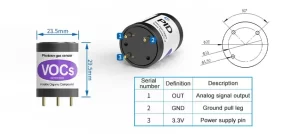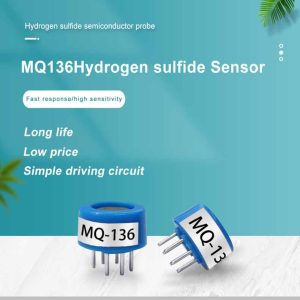Air pollution has become a major global issue, with millions of premature deaths attributed to poor air quality annually. It is therefore essential to have effective air quality monitoring systems in place to track and mitigate the impacts of air pollution. Traditional air quality monitoring systems rely on large and expensive equipment, often limited to stationary locations, making it challenging to obtain real-time data. However, with advancements in gas sensor technology, air quality monitoring has become more accessible and efficient than ever before.

What are Gas Sensors?
Gas sensors are devices that detect and measure the presence and concentration of specific gases in the air. These sensors are designed to identify a range of gases, including nitrogen dioxide, carbon monoxide, sulfur dioxide, ozone, and volatile organic compounds, among others. They work by converting the concentration of the target gas into an electrical signal, which can be measured and analyzed.
Advantages of Gas Sensors for Air Quality Monitoring
There are several advantages of using gas sensors for air quality monitoring, including:
Real-time data: Gas sensors provide real-time data, allowing for immediate detection and response to changes in air quality.
Portability: Gas sensors are compact and portable, making them ideal for mobile monitoring.
Cost-effective: Gas sensors are relatively inexpensive compared to traditional air quality monitoring equipment, making it possible to deploy multiple sensors in different locations.
Multipurpose use: Gas sensors can detect a wide range of gases, making them useful for various air quality monitoring applications.
Applications of Gas Sensors for Air Quality Monitoring
Gas sensors find widespread applications in air quality monitoring across various sectors, including:
Urban air quality monitoring: Gas sensors are widely used to monitor urban air quality, particularly near busy roads and industrial areas. The sensors help identify high levels of pollutants in real-time, enabling authorities to take immediate action to mitigate the effects of air pollution.
Indoor air quality monitoring: Gas sensors are useful in monitoring indoor air quality, particularly in residential and office buildings. The sensors help identify sources of indoor air pollution, such as cooking appliances, cleaning chemicals, and tobacco smoke, among others.
Industrial emissions monitoring: Gas sensors are used to monitor emissions from industrial processes, helping industries comply with regulatory requirements and reduce their environmental impact.
Mobile air quality monitoring: Gas sensors can be deployed on mobile platforms, such as cars or drones, to provide real-time data on air quality across a wide area.
Challenges in Gas Sensor Technology for Air Quality Monitoring
While gas sensors offer several advantages for air quality monitoring, some challenges remain, including:
Reliability and accuracy: The reliability and accuracy of gas sensors can vary across different models and manufacturers. Proper calibration and maintenance are essential to ensure reliable and accurate measurements.
Cross-sensitivity: Gas sensors can be sensitive to other gases present in the air, leading to false readings. This can be mitigated by using sensors specifically designed to detect specific gases.
Standardization: There is a lack of standardization in gas sensor technology, making it difficult to compare data obtained from different sensors.

Data analysis: Handling and analyzing large amounts of data from multiple sensors can be challenging and require specialized software and expertise.
Future Directions in Gas Sensor Technology for Air Quality Monitoring
The future of gas sensor technology in air quality monitoring lies in advancements in sensor design, data analytics, and integration with other technologies. Miniaturized sensors, wireless networks, and remote sensing technologies will enhance the spatial coverage and accessibility of air quality data. Furthermore, machine learning algorithms and artificial intelligence can be leveraged to improve data analysis, anomaly detection, and prediction capabilities. Integration with other technologies, such as the Internet of Things (IoT) and cloud computing, will enable more efficient and streamlined air quality monitoring systems.
Conclusion
Gas sensors have revolutionized air quality monitoring, making it more accessible, efficient, and cost-effective than ever before. With ongoing advancements in sensor technology and data analytics, we can expect to see more widespread adoption of gas sensor-based air quality monitoring systems. This will enable more informed decision-making, leading to the mitigation of air pollution's adverse effects on public health and the environment.
 : +86 155 8830 2704
: +86 155 8830 2704 : jxdziot@gmail.com
: jxdziot@gmail.com
